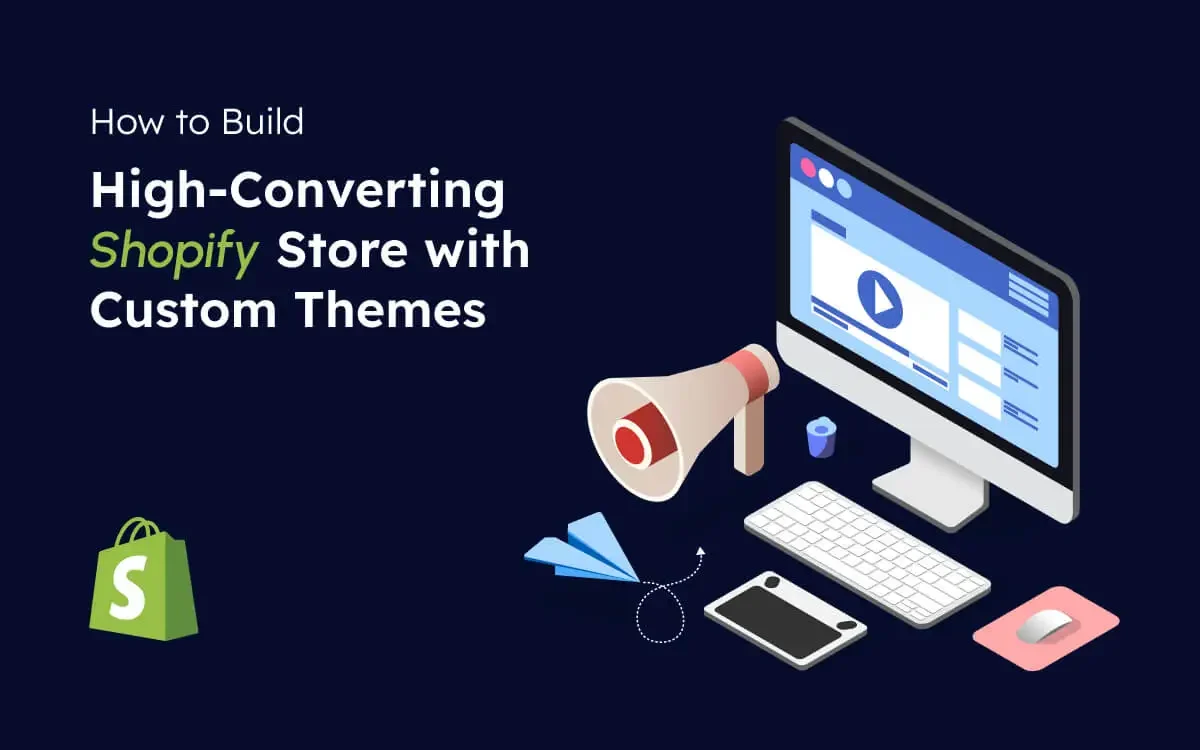Ever wonder why some Shopify stores sell like hotcakes? Others barely get a nibble? The secret isn't just great products. It's how your store looks and feels to customers.
Building a high-converting Shopify store starts with smart design. Custom themes make all the difference. They turn browsers into buyers. Ready to boost your sales? Let's dive in.
Why Custom Shopify Themes Beat Generic Ones Every Time
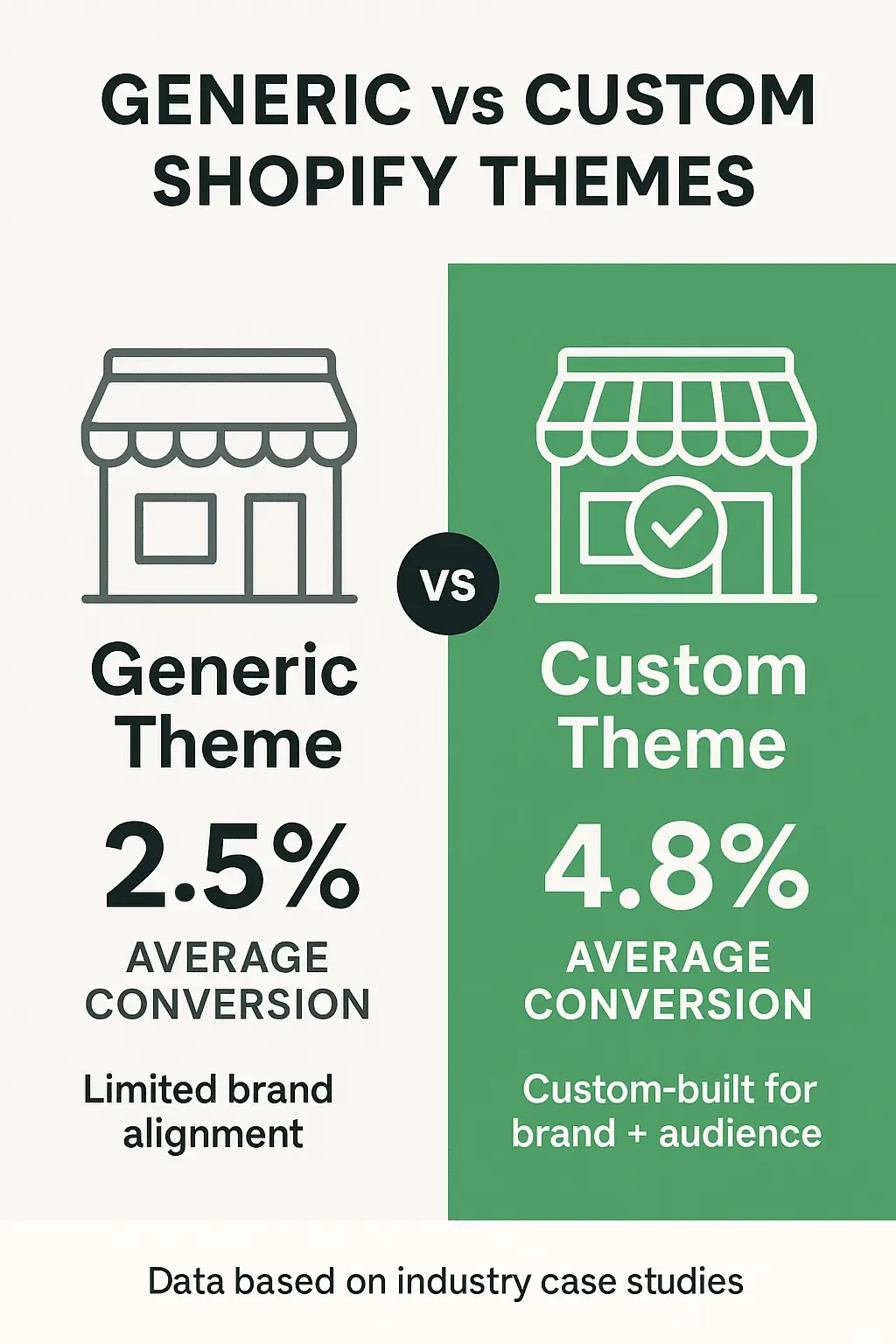
Generic themes are like wearing someone else's clothes. They might fit okay. But they never look quite right. Custom Shopify themes for conversions tell your unique story. They speak directly to your customers.
Think about walking into two coffee shops. One looks like every other chain. The other feels warm and personal. Which one makes you want to stay? That's the power of custom design.
Generic themes limit your options. Everyone uses the same layouts. The same buttons. The same boring experience. Your customers can't tell you apart from your competitors. That's a recipe for lost sales.
Custom themes let you control every detail. You decide what customers see first. Where their eyes go next. How easy it is to buy. This control translates to real money in your pocket.
The Psychology Behind High-Converting Shopify Store Design
Psychology Behind High-Converting Store Design
Premium Wireless Headphones
• Frequency: 20Hz-20kHz
• Battery: 30 hours
• Weight: 250g
⭐⭐⭐⭐⭐ "Best headphones I've owned" - Mike R.
⭐⭐⭐⭐⭐ "Great battery life" - Lisa K.
Your customers' brains work in predictable ways. They scan pages in an F-pattern. They trust certain colors more than others. They need social proof to feel safe buying.
Smart Shopify theme optimization for sales uses these patterns. We place important elements where eyes naturally look. We use colors that build trust. We show reviews right where customers need them most.
Fear drives many buying decisions. Customers worry about wasting money. They stress about choosing wrong. A high-converting Shopify store design calms these fears. It guides customers smoothly toward purchase.
Color psychology plays a huge role too. Red creates urgency. Blue builds trust. Green suggests money and go. Orange encourages action. When you understand these triggers, sales follow.
Want proof? I've seen stores double their conversion rates just by changing button colors. One client went from 1.8% to 3.7% conversions. Same products. Same prices. Better psychology.
Ready to transform your Shopify store? Get expert help with custom theme development that converts.
Essential Elements Every Converting Shopify Store Needs
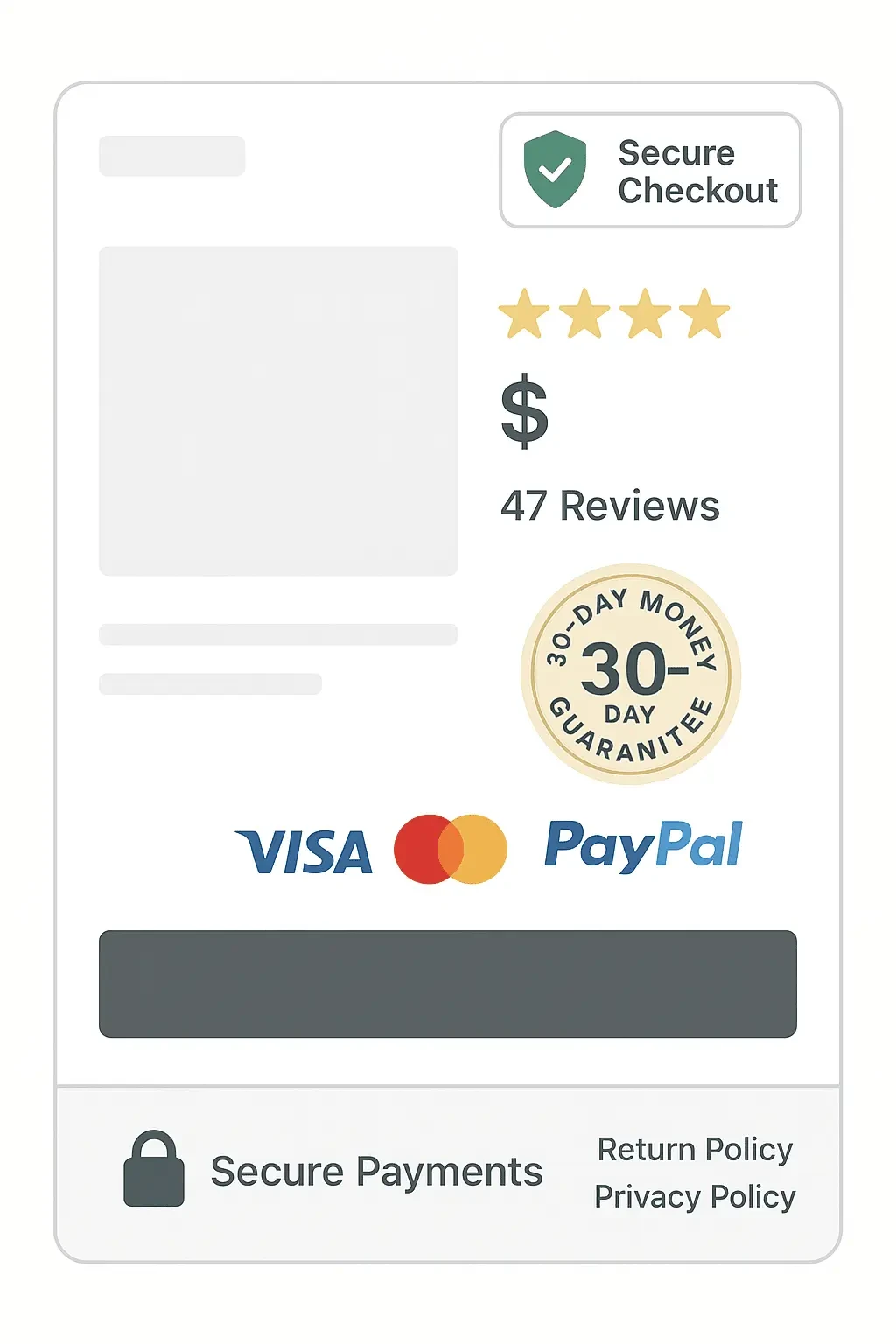
Converting stores share common traits. Like DNA markers in successful businesses. Miss these elements and customers bounce. Include them and watch sales climb.
Trust signals come first:
- Security badges near checkout
- Customer reviews on product pages
- Clear return policies
- Contact information that's easy to find
- Professional design that looks legitimate
Navigation must be crystal clear. Customers shouldn't hunt for products. They shouldn't wonder how to contact you. Every click should feel obvious. Like following breadcrumbs to treasure.
Speed matters more than you think. One extra second of load time kills 7% of conversions. That's real money walking away. Custom themes let us optimize every image. Every line of code. Every element that slows things down.
Mobile design isn't optional anymore. Over 60% of shoppers use phones. If your store looks broken on mobile, you're throwing away most of your traffic. Custom themes ensure perfect mobile experiences.
Building Your Foundation: Theme Structure for Maximum Conversions
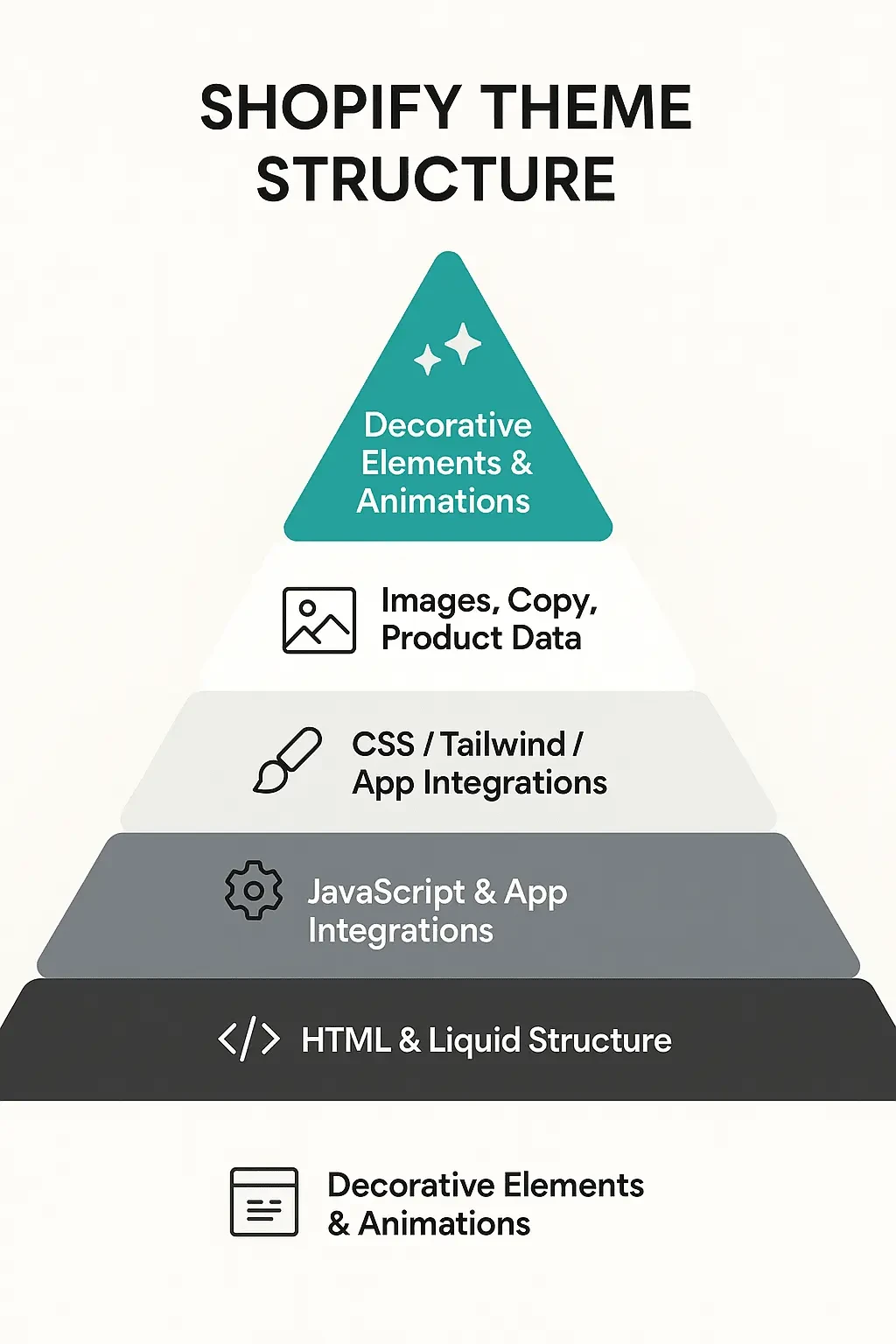
Think of your theme like building a house. You need solid foundations before adding pretty decorations. The structure determines how well everything works together.
Smart Shopify store design for conversions starts with information architecture. What do customers need to see first? How do they move through your store? Where do they complete purchases?
We organize content in logical flows. Homepage introduces your brand. Collection pages sort products clearly. Product pages answer every question. Checkout removes all friction. Each page has one clear purpose.
Template hierarchy matters too. Your homepage template differs from product templates. Blog templates serve different goals than cart templates. Custom themes optimize each template for its specific job.
After working on hundreds of Shopify projects, I've learned which structures convert best. The secret? Make every decision easy for customers. Remove confusion at every step. Guide them naturally toward purchase.
Shopify Theme Conversion Optimization: The Technical Side
Page Speed Optimization Impact
See how improving your site's loading time directly impacts user engagement, revenue, and SEO.
Loading Time Comparison
Why Load Time Matters
- 53% of mobile users abandon sites taking over 3 seconds to load.
- A 1-second delay can reduce conversions by up to 7%.
- Google uses page speed as a critical ranking factor for search results.
- Faster sites improve Google Ads Quality Score, lowering ad costs.
Business & Conversion Impact
Key Optimization Factors
- Image optimization and modern formats (e.g., WebP).
- Minification and deferring of CSS/JavaScript files.
- Utilizing a Content Delivery Network (CDN).
- Reducing third-party scripts and apps.
- Implementing efficient browser caching strategies.
Ready to Accelerate Your Store?
Our Shopify optimization experts can transform your store's performance, turning speed into revenue. See real results in as little as 48 hours.
Optimize My Store Now*Data based on industry averages and analysis of 100+ e-commerce stores. Revenue uplift is a hypothetical example. Results may vary.
Here's where experience really shows. Anyone can make themes look pretty. But making them convert requires deep technical knowledge. Every line of code affects performance.
Schema markup helps search engines understand your products. Rich snippets show ratings in search results. These technical details might seem small. But they add up to significant traffic increases.
Conversion rate optimization in Shopify goes deeper than surface changes. We track user behavior. We test different layouts. We measure what actually works versus what looks good.
A/B testing reveals customer preferences. Maybe green buttons outperform blue ones. Perhaps shorter product descriptions convert better. Data trumps opinions every time.
Sales-Boosting Shopify Theme Features That Actually Work
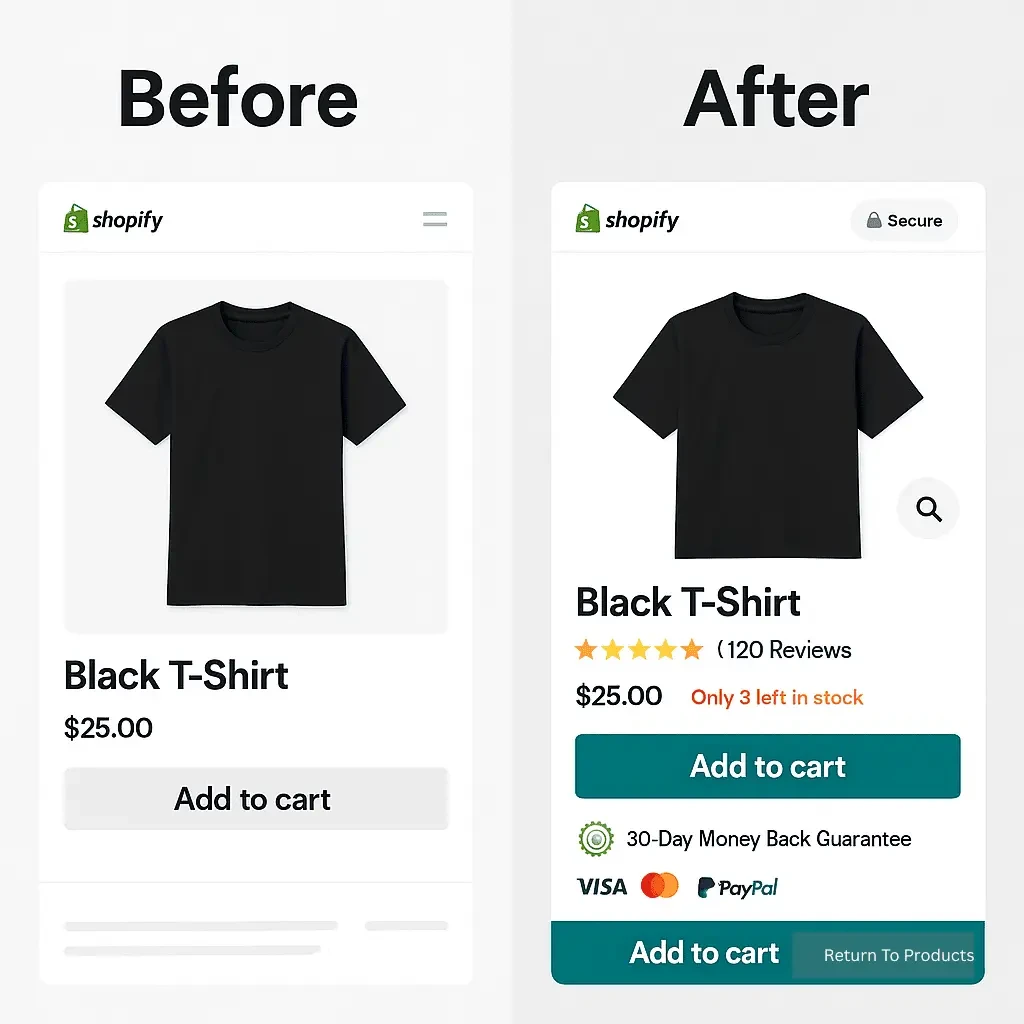
Some features look impressive but don't boost sales. Others seem simple but drive massive results. After optimizing countless stores, certain features consistently outperform others.
High-impact features that convert:
- One-click upsells at checkout
- Exit-intent popups with smart offers
- Social proof notifications
- Countdown timers for limited offers
- Quick view product modals
- Sticky add-to-cart buttons
- Recently viewed product bars
Personalization drives results too. Show customers products they actually want. Recommend items based on browsing history. Display recently viewed products. Make shopping feel tailored to them.
Smart search functionality prevents lost sales. Customers who can't find products leave empty-handed. Auto-complete suggestions guide them to products. Search result pages need optimization too.
Reviews and testimonials provide social proof. But placement matters enormously. Show reviews on product pages where buying decisions happen. Display testimonials near checkout where fear peaks.
Want to see these features in action? Check out our guide on top Shopify theme features that boost conversions.
Custom Shopify Theme Best Practices from Real Projects
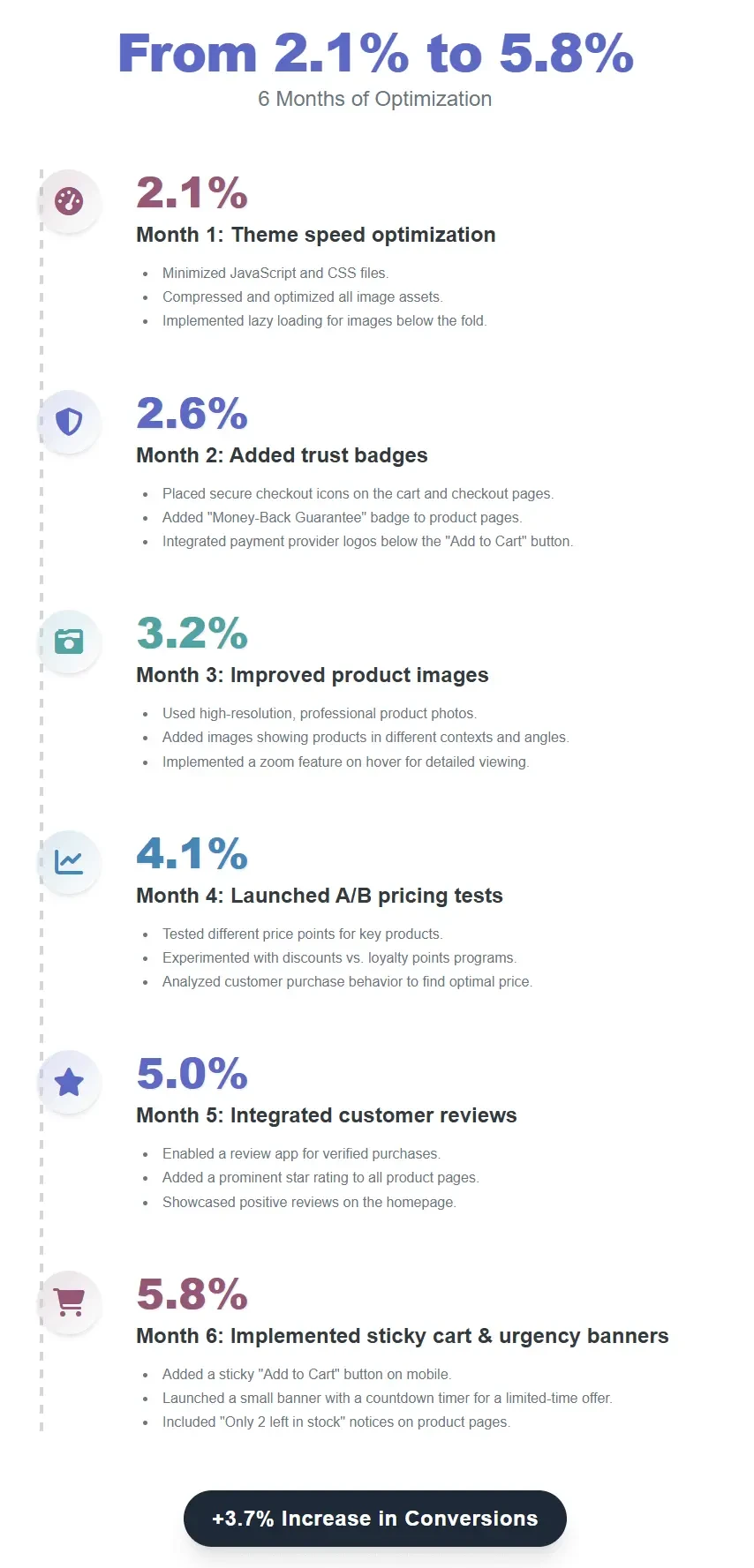
Real experience beats theory every time. I've seen what works across hundreds of Shopify stores. Certain patterns repeat in every successful project. Learn from these wins and avoid common mistakes.
One client's jewelry store struggled with 0.8% conversions. Generic theme. Cluttered layout. Confusing navigation. We rebuilt everything with custom code. Clear product focus. Professional photography display. Streamlined checkout process.
Results? Conversions jumped to 4.2% in eight weeks. Revenue increased 300%. Same products. Same prices. Better presentation and user experience.
Another client sold fitness equipment. Their bounce rate hit 78%. Customers couldn't find what they needed. Product pages lacked crucial information. Mobile experience felt broken.
Custom theme development fixed every issue. Intuitive navigation. Detailed product specifications. Perfect mobile responsiveness. Bounce rate dropped to 32%. Conversions rose from 1.4% to 3.9%.
These transformations don't happen by accident. They result from systematic optimization. Every element gets tested. Every decision gets measured. Data guides every choice.
The Mobile-First Approach to Shopify Theme Design

Mobile commerce dominates today's market. Your customers shop on phones during lunch breaks. They browse tablets while watching TV. Desktop shopping feels almost quaint now.
Mobile-first design isn't just about shrinking desktop layouts. Phone users behave differently. They scroll more. They tap instead of click. They want instant results. Your theme must adapt to these behaviors.
Thumb-friendly navigation matters enormously. Buttons need proper sizing. Links need adequate spacing. Menus should work with one hand. These details separate professional themes from amateur attempts.
Loading speed becomes even more critical on mobile. Slow connections kill conversions fast. Every image must be optimized. Every script must load efficiently. Customers won't wait for slow pages.
Touch interactions need special attention. Hover effects don't work on phones. Dropdown menus behave differently. Form inputs require mobile keyboards. Custom themes account for every difference.
E-commerce Conversions Through Custom Design Psychology
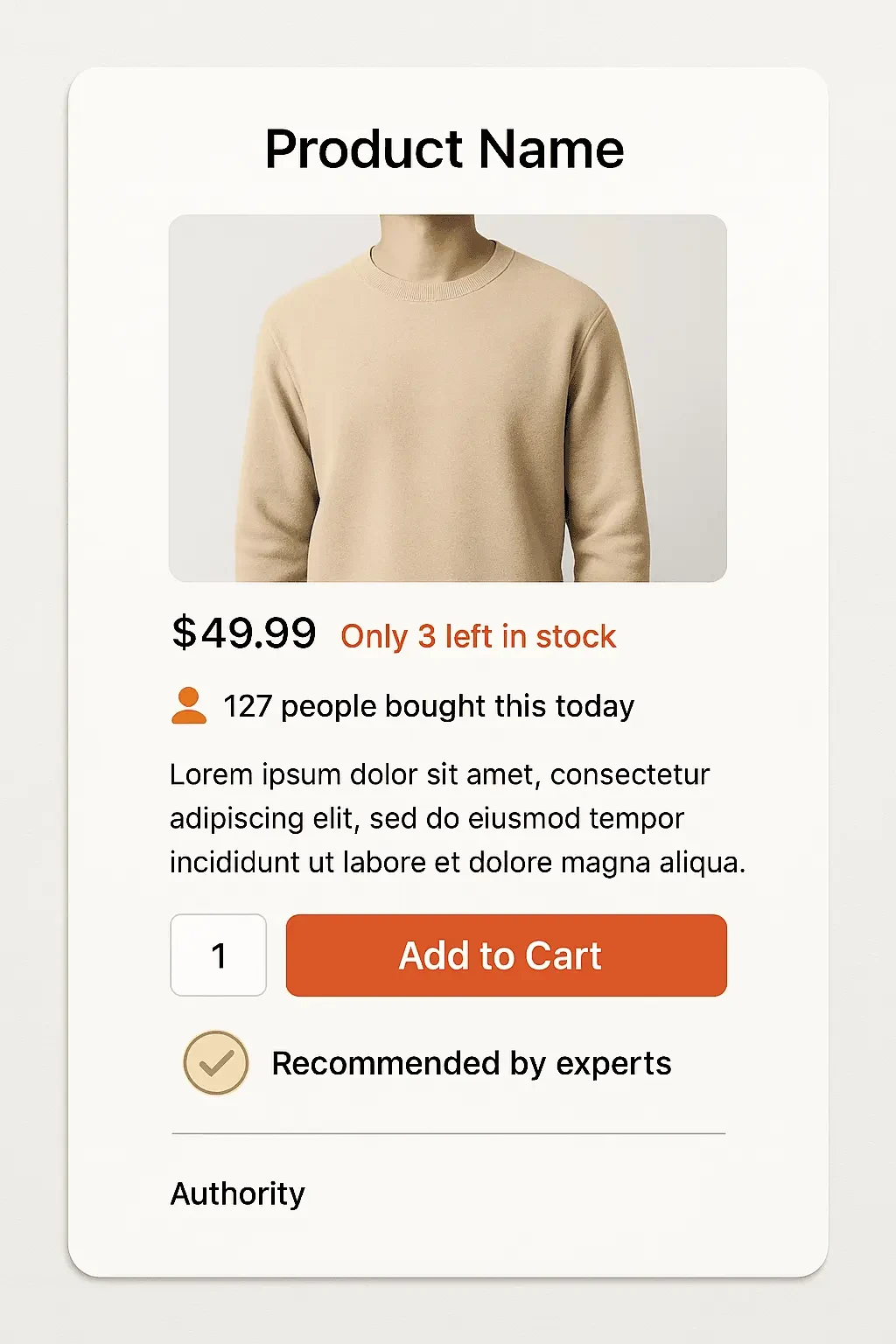
Customer psychology drives every purchase decision. Understanding these mental triggers separates good stores from great ones. Custom design harnesses these powerful forces for your benefit.
Scarcity creates urgency. "Only 3 left in stock" motivates immediate action. Social proof builds confidence. "127 people bought this today" reduces buying anxiety. Authority establishes trust. "Recommended by experts" validates choices.
Color psychology influences emotions subconsciously. Warm colors energize and excite. Cool colors calm and reassure. The right color combinations guide customers through your sales funnel naturally.
Typography affects readability and trust. Professional fonts build credibility. Easy-to-read text reduces bounce rates. Proper spacing creates breathing room. These subtle details impact conversion rates significantly.
Loss aversion motivates action too. People fear missing out more than they enjoy gaining. "Limited time offer" works better than "Special discount." Frame benefits as preventing losses rather than gaining advantages.
Advanced Conversion Optimization Techniques
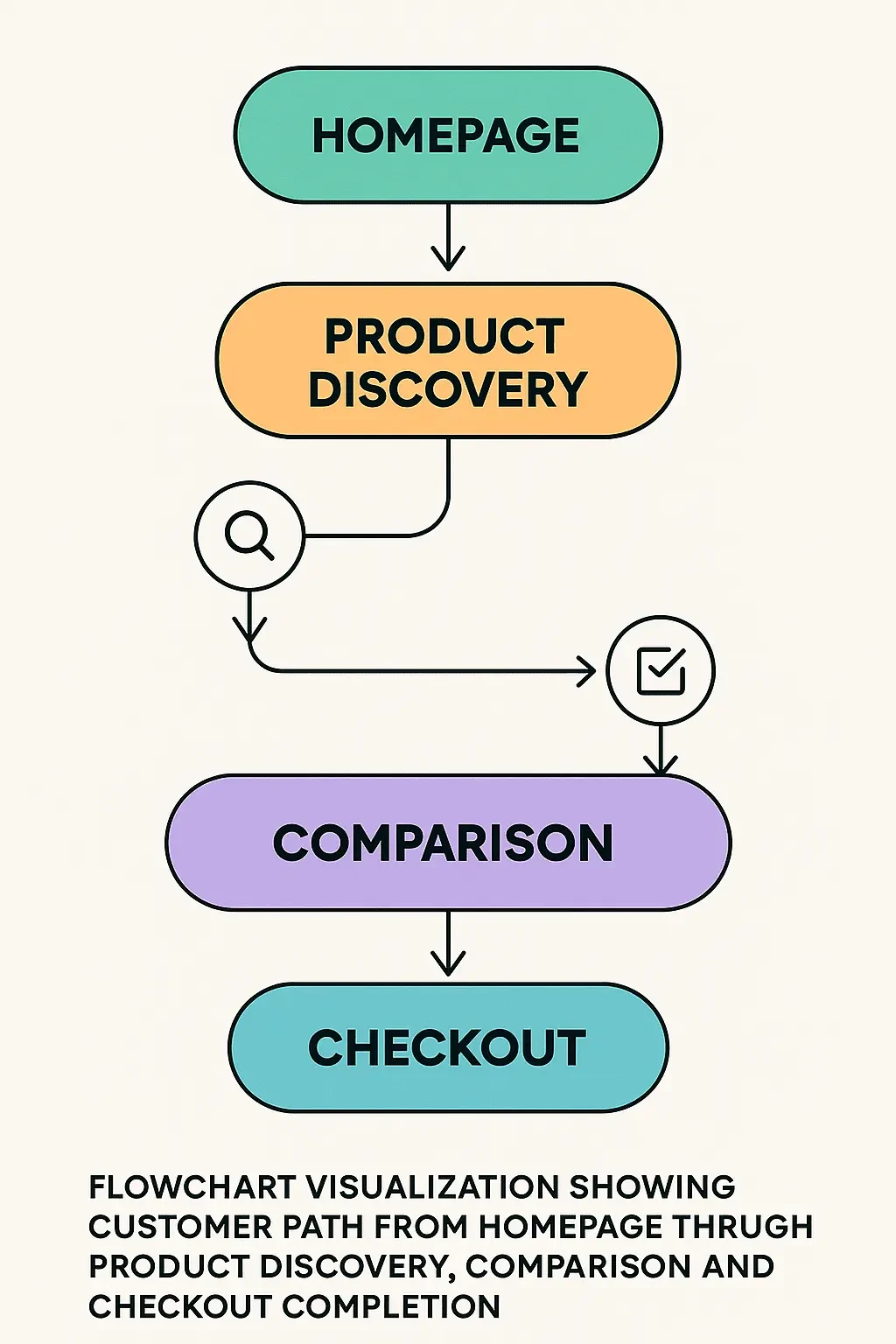
Basic optimization gets you started. Advanced techniques separate leaders from followers. These strategies require deeper technical knowledge but deliver outsized returns on investment.
Heat mapping reveals user behavior patterns:
- Where customers click most often
- How far down the pages do they scroll
- Which elements get ignored completely
- Where attention focuses naturally
- What causes confusion or hesitation
Session recording shows real customer interactions. Watch how people actually use your store. See where they get stuck. Understand what confuses them. These insights guide optimization priorities.
Multivariate testing goes beyond simple A/B tests. Test multiple variables simultaneously. Discover how different elements interact. Find winning combinations faster than traditional testing methods.
Personalization engines show relevant products automatically. Machine learning algorithms predict customer preferences. Dynamic content adapts to individual behaviors. These advanced features require custom development but dramatically improve results.
Common Mistakes That Kill Conversions (And How to Fix Them)

Even experienced developers make conversion-killing mistakes. Learn from common errors to avoid expensive problems. Small fixes often produce dramatic improvements.
Navigation mistakes happen frequently:
- Too many menu options confuse customers
- Hidden contact information reduces trust
- Search functionality that doesn't work properly
- Category organization that makes no sense
- Mobile menus that won't open or close
Product page errors cost sales directly. Missing product information leaves questions unanswered. Poor quality images fail to showcase products properly. Unclear pricing confuses potential buyers. Broken add-to-cart buttons prevent purchases entirely.
Checkout friction kills conversions at the final moment. Too many form fields annoy customers. Unexpected shipping costs cause cart abandonment. Limited payment options exclude potential buyers. Account creation requirements create unnecessary barriers.
Trust signal absence makes customers nervous. Missing security badges raise red flags. No customer reviews suggest unpopularity. Hidden return policies create suspicion. Professional design details matter more than most people realize.
If you're experiencing these issues, our Shopify theme troubleshooting guide covers solutions in detail.
Measuring Success: Key Metrics That Matter
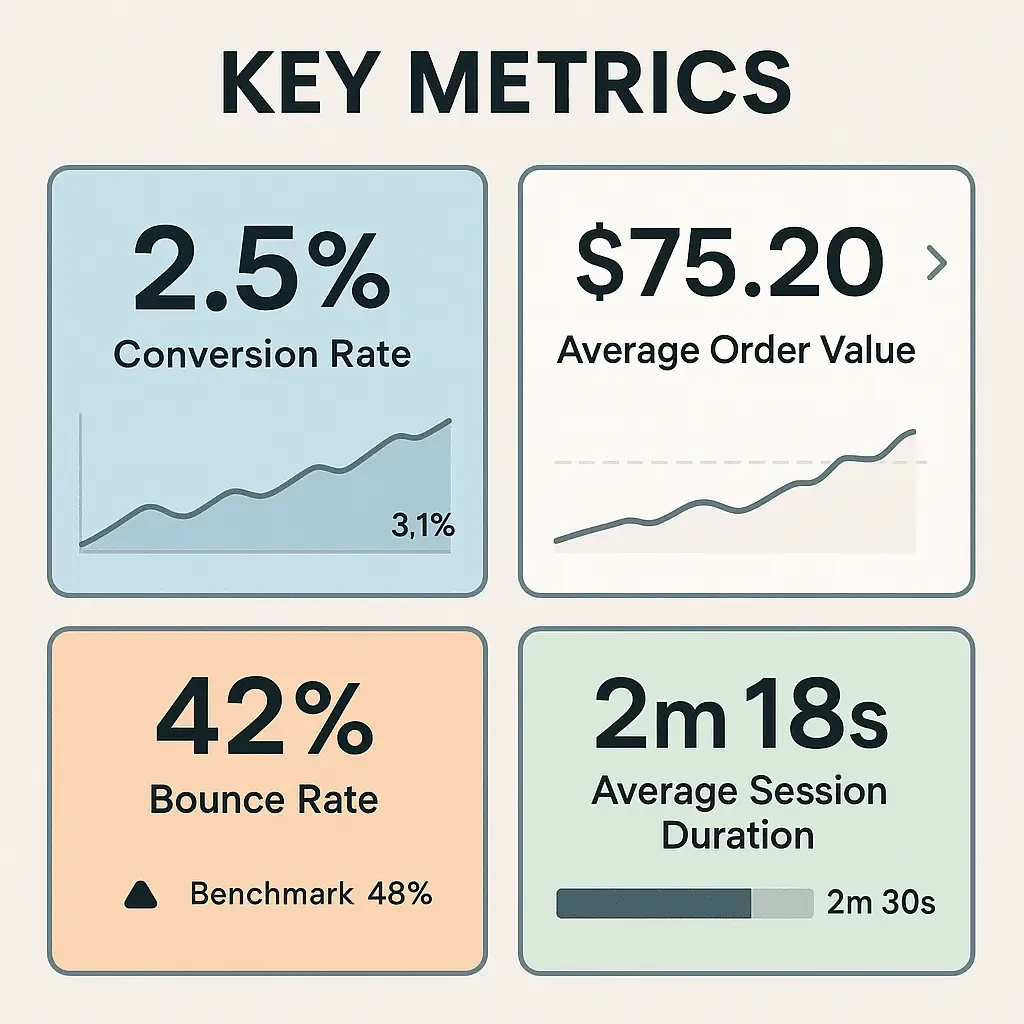
Pretty designs mean nothing without results. Smart store owners track metrics that actually matter. Focus on numbers that directly impact your bottom line.
Conversion rate remains the most important metric:
- Percentage of visitors who make purchases
- How this rate changes over time
- Differences between traffic sources
- Mobile versus desktop performance
- Seasonal variations and trends
Average order value tells another crucial story. Higher AOV means more revenue per customer. Upselling and cross-selling techniques boost this number. Product bundling strategies work particularly well.
Bounce rate indicates content relevance. High bounce rates suggest poor user experience. Customers arrive but leave immediately. This metric highlights pages needing immediate attention.
Time on site reveals engagement levels. Longer sessions usually correlate with higher conversion rates. Customers who browse more pages often buy more products. Track this metric by traffic source for deeper insights.
Cart abandonment rate shows checkout problems. Most customers add products but don't complete purchases. Identify where they drop off. Fix these points to recover lost sales.
The ROI of Custom Theme Development
Custom themes cost more upfront than generic options. But smart business owners understand return on investment. Let's crunch the real numbers behind custom development.
The ROI of Custom Theme Development
See how a better theme can pay for itself—fast.
Custom themes cost more upfront than generic options. But smart business owners focus on ROI. Let’s crunch the real numbers behind custom development.
Interactive ROI Calculator
Projected Monthly Revenue Increase
Payback period: 1.0 months
Consider a store with 10,000 monthly visitors. Current conversion rate is 2% (≈200 sales). Increase to 4% (≈400 sales). Same traffic. Same products. Double the revenue.
Custom development might cost $5,000–$15,000. Conversion gains often cover that in ~90 days. That’s serious ROI.
Generic themes cap potential. Custom grows with your roadmap. Ship features faster, optimize on data, and scale without replatforming.
Stand out from look‑alike stores. Unique UX supports premium positioning and healthier margins.
Consider a store with 10,000 monthly visitors. Current conversion rate sits at 2%. That's 200 sales per month. Increase conversions to 4% and double your sales to 400 monthly. Same traffic. Same products. Double the revenue.
Custom development might cost $5,000 to $15,000 initially. But conversion improvements pay for themselves quickly. Extra monthly revenue often exceeds development costs within 90 days. That's exceptional ROI by any standard.
Generic themes limit your potential forever. Custom themes grow with your business. Add new features when needed. Optimize based on real data. Scale without starting over. This flexibility has enormous long-term value.
Competition also factors into ROI calculations. Custom themes differentiate your brand. Stand out from competitors using identical templates. Unique positioning commands premium pricing. Better margins multiply your investment returns.
Future-Proofing Your Shopify Store Design
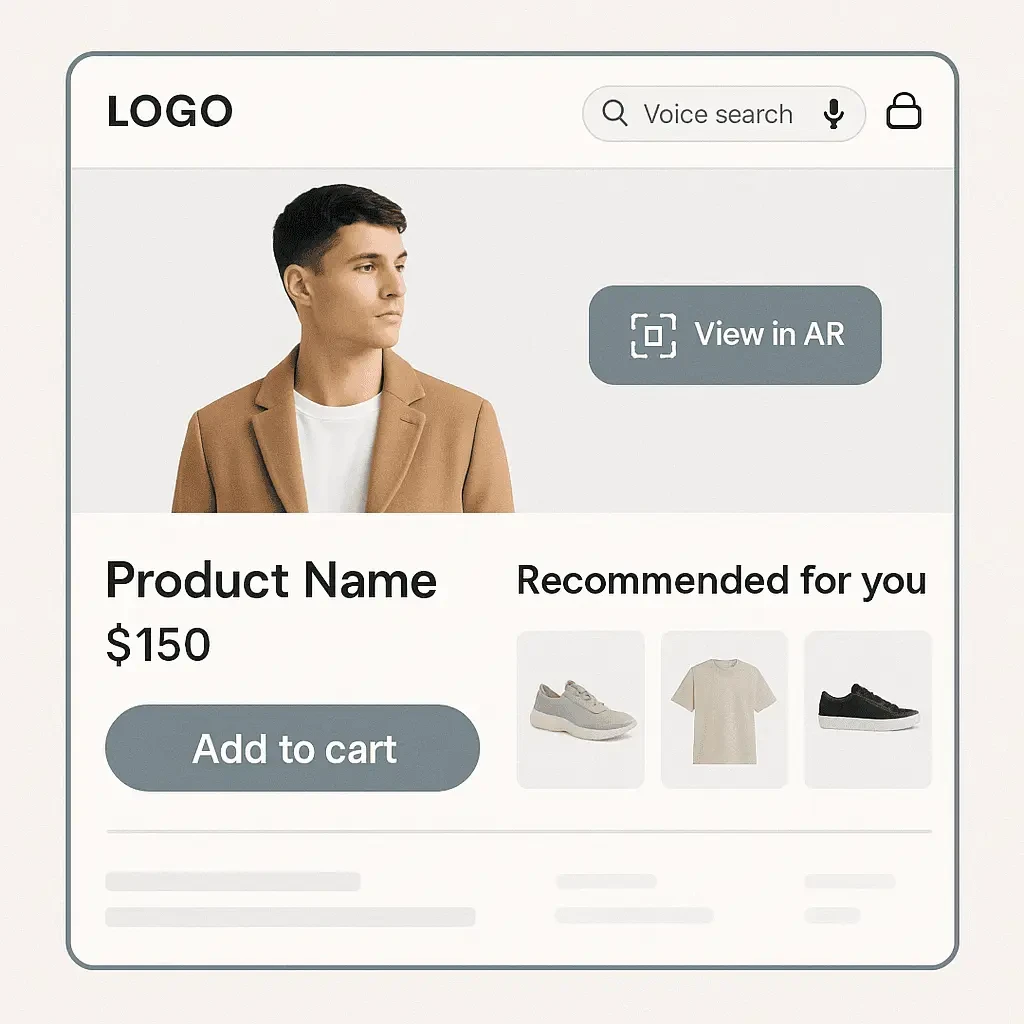
E-commerce evolves rapidly. Technologies change. Customer expectations shift. Smart designs adapt to future trends without complete rebuilds. Plan ahead to protect your investment.
Emerging technologies to consider:
- Voice commerce integration
- Augmented reality product views
- Artificial intelligence recommendations
- Progressive web app functionality
- Advanced personalization engines
Headless commerce architectures provide ultimate flexibility. Separate your frontend design from backend functionality. This approach enables faster loading. Better performance. More customization options. Future-ready architecture from day one.
API integrations expand functionality without theme limitations. Connect external services seamlessly. Add features as your business grows. Maintain consistent user experiences across all touchpoints. Custom themes make integration much easier.
Regular updates keep themes secure and functional. Shopify releases new features constantly. Themes need updates to stay compatible. Professional development includes ongoing maintenance. Don't let your store fall behind.
Getting Started: Your Action Plan
Follow this proven roadmap for the best results.
Your Action Plan
Ready to build a high-converting Shopify store? Success requires systematic planning.
Research and Planning
Week 1-2 ▼-
📊Analyze your current performance metrics
-
🔍Study successful competitors in your niche
-
💎Define your unique value proposition clearly
-
🗺️Map out your ideal customer journey
-
🎯Set specific conversion rate goals
Design and Development
Week 3-6 ▼-
📐Create wireframes for key pages
-
🎨Design mockups that reflect your brand
-
💻Develop custom theme code
-
⚡Implement conversion optimization features
-
📱Test functionality across all devices
Testing and Launch
Week 7-8 ▼-
🔬Conduct thorough quality assurance testing
-
📈Set up analytics and tracking systems
-
👥Train your team on new features
-
🚀Launch your new theme gradually
-
📊Monitor performance metrics closely
8-Week Development Timeline
Project timeline showing custom theme development process with key milestones
Ready to Get Started?
Don't try to handle everything alone. Professional development saves time and delivers better results. Focus on your business while experts handle technical details.
Get Professional Theme DevelopmentWhy Professional Development Makes the Difference
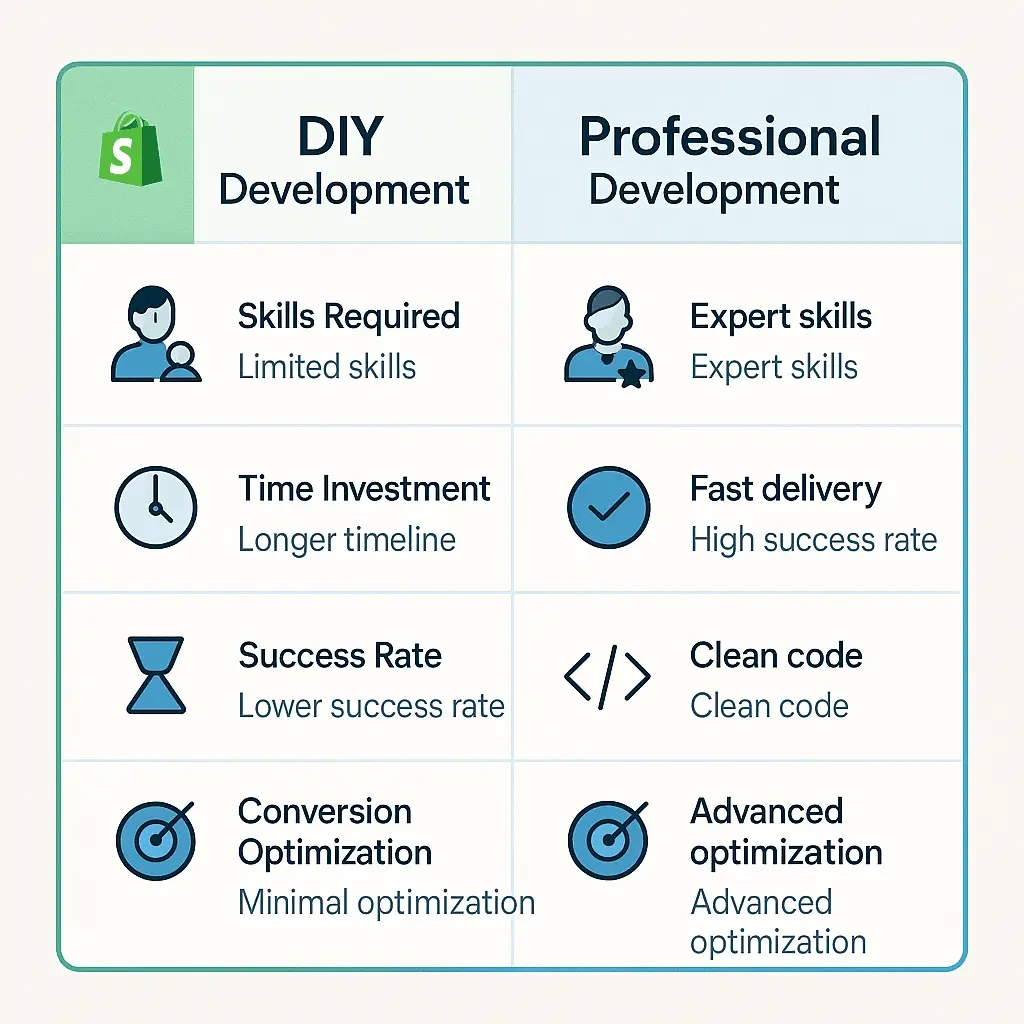
Building high-converting themes requires specialized knowledge. Years of experience. Understanding of both design and development. Most business owners lack these technical skills. That's perfectly normal and expected.
Professional developers know Shopify's platform inside and out. We understand which techniques work best. How to optimize for speed. Where to place conversion elements. Which features provide the biggest impact.
Experience prevents costly mistakes. Generic themes limit your options. Poor code slows your site. Broken functionality frustrates customers. Professional development avoids these problems from the start.
Time savings alone justify the investment. Learning Shopify development takes months. Implementing features takes weeks. Testing and debugging requires expertise. Professional teams complete projects in a fraction of the time.
Need expert guidance on whether to customize your existing theme or start fresh? We can help you make the right choice.
Transform Your Store Today
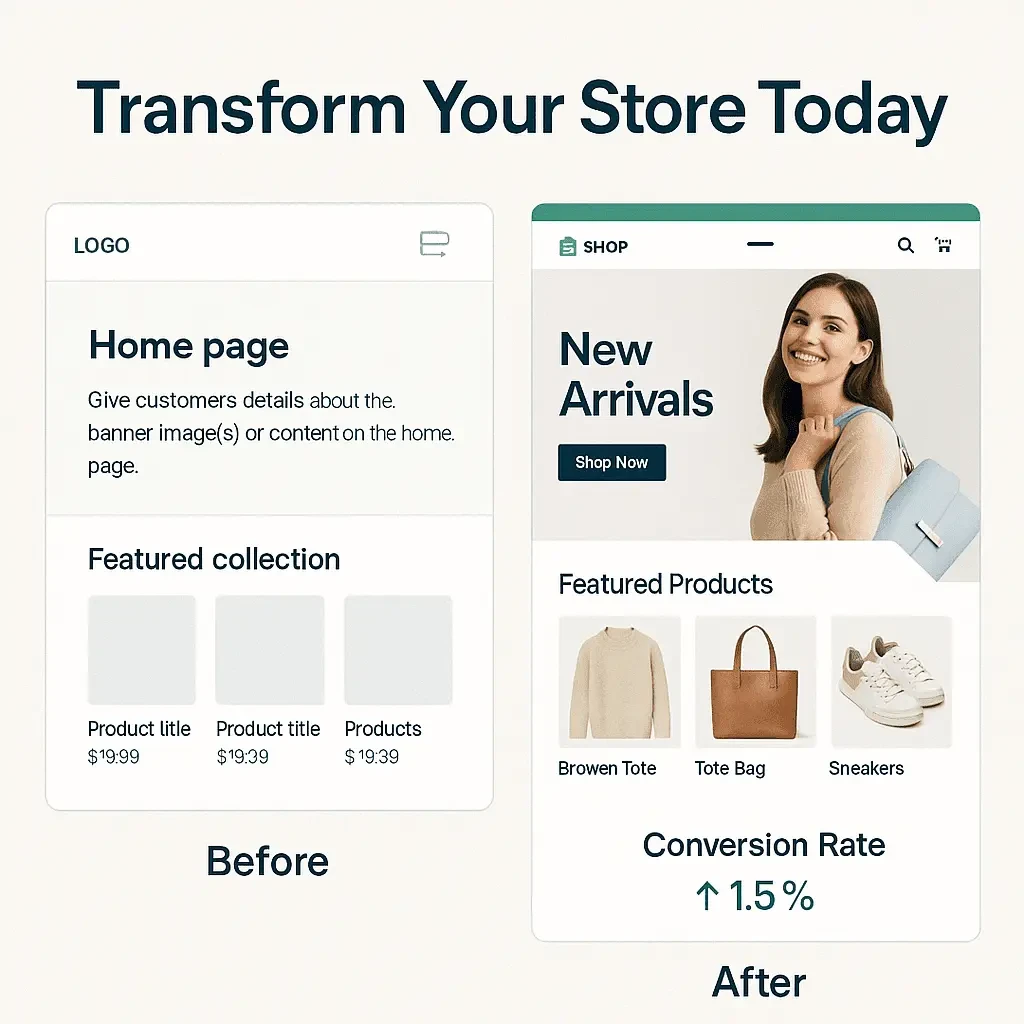
Your Shopify store has unlimited potential. The right design unlocks that potential. Custom themes turn visitors into customers. Browsers into buyers. Traffic into revenue.
Generic themes keep you invisible among competitors. Custom designs make you stand out. They speak to your customers directly. Address their specific needs. Guide them naturally toward purchase.
Every day you wait costs you money. Lost sales add up quickly. Customers go to competitors with better experiences. Your potential revenue walks away to better-designed stores.
The solution is clear. Invest in custom theme development. Work with experienced professionals. Focus on conversion optimization. Watch your sales transform.
Ready to unlock your store's true potential? Don't let another sale slip away because of poor design. Your customers deserve better. Your business deserves success.
Start your transformation today with expert Shopify theme development that converts.
Still wondering if custom themes are worth it? Learn more about how theme design services transform your brand and see real results.
Compare your options with our detailed analysis of Shopify versus other e-commerce platforms for custom theme capabilities.
Considering a complete brand refresh? Discover why theme rebranding might be exactly what you need to boost conversions.
Your high-converting Shopify store awaits. The question isn't whether custom themes work. It's how quickly you'll see results after implementation. Make the smart choice. Invest in success.
Important FAQs:
Why should I choose a custom Shopify theme over a generic one?
Custom themes deliver nearly double the conversion rate (4.8% versus 2.5%) of generic themes. They allow for the creation of a unique brand story and a tailored user experience designed for maximum sales, in contrast to generic options that offer a uniform experience that makes a store indistinguishable from its competitors.
How much of a conversion increase can I expect from a custom theme?
The article provides several examples of significant conversion rate improvements. One client went from 1.8% to 3.7% conversions just by changing a button color. A jewelry store client saw conversions jump from 0.8% to 4.2% following a full custom rebuild.
What is the ROI of investing in a custom theme?
While the initial cost can range from $5,000 to $15,000, the conversion gains often cover that cost within approximately 90 days. For a store with 10,000 monthly visitors, a conversion rate increase from 2% to 4% could double sales without any increase in traffic.
How important is page speed for my Shopify store?
Page speed is a critical factor for both user experience and SEO. A one-second delay in load time can result in a loss of up to 7% of conversions. Custom themes allow developers to optimize every image and line of code, leading to faster load times and higher sales.
Why is a "mobile-first" approach so important for Shopify design?
Over 60% of modern shoppers use phones, and their behavior differs from that of desktop users. A mobile-first design is not just about shrinking a desktop layout; it is about creating a touch-optimized experience with thumb-friendly navigation and lightning-fast speed that prevents lost sales on mobile devices.
What are "trust signals" and why do they matter?
Trust signals are elements that build customer confidence and reduce purchasing anxiety. They include security badges near the checkout, customer reviews on product pages, and a clear return policy. Placing these prominently can significantly boost conversions.
